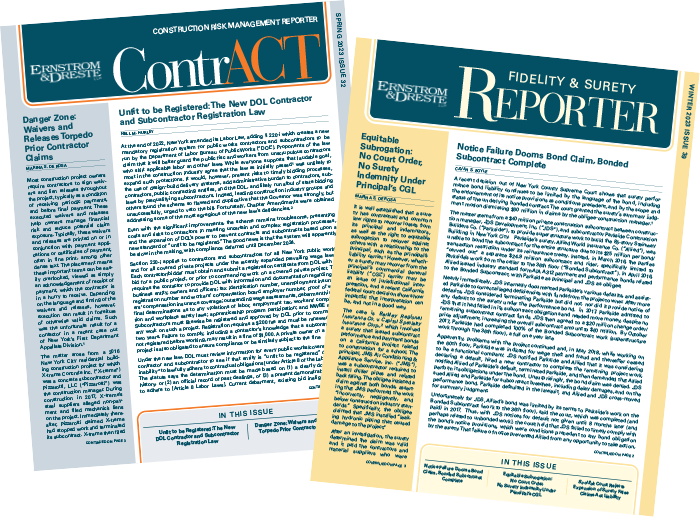Article by: Cavan S. Boyle
A recent New York appellate decision upheld the denial of a contractor’s extra work claim that alleged owner plan errors and misrepresentations, finding instead that the contractor’s failure to determine actual field dimensions prior to its design and procurement of a safety component precluded owner liability.1 The contractor thus bore significant unanticipated costs for redesign and procurement.
The matter involved a 2018 public construction project between American Bridge Company (“AB”) and the New York City Department of Transportation (“DOT”) to repair and replace parts of the upper level to the Ed Koch Queensboro Bridge.
As a part of the contract, AB was to supply a temporary protective shield for workers’ safe access to the site while protecting and maintaining minimum vertical clearance for traffic on the roadway below.2 The contract, and a DOT answer to a pre-bid question, specified that the DOT estimates of vertical clearance dimensions were from original bridge drawings, that actual field dimensions may differ from plans, and that contractor must “verify actual dimensions as needed.” A request to field measure dimensions prior to bid was denied by DOT. AB subcontracted for the shields based upon the DOT estimates.
When work began, AB took its first field measurements and discovered the vertical clearance was shorter than DOT’s estimate. AB claimed DOT pre-bid information caused discrepancies in AB’s shield design, requiring a change to the shield installation plan, leading to added costs. DOT denied AB’s claim for additional payment, citing AB’s obligation to verify the minimum vertical clearance per its design obligation under the contract and because “means and methods for erecting” the shield were AB’s responsibility. An administrative ruling found in favor of DOT, followed by the state court’s dismissal of AB’s petition to annul that determination. AB appealed.
The appellate court affirmed the lower court’s ruling, finding the contract instructed AB not to rely on the contract plan dimensions, to verify existing field dimensions, and thus DOT was exculpated from liability.3 The court explained:
“The contract’s ample qualifying language precludes [AB] from recovering the costs…to conform its design to the field dimensions regardless of when [AB] was able to take measurements.”
The court was unconvinced by AB’s efforts to distinguish between the contracted requirement to confirm or “verify” DOT’s estimates post-bid, and an unexpected (and unreasonable) obligation to “determine” the measurements for itself for bidding/procurement purposes, without access to do so. AB argued unsuccessfully that the “verify-in-field” clause was intended to alert DOT of discrepancies before shield installation rather than to shift the risk of any discrepancies to AB.
The court also rejected AB’s contention that DOT’s plans and pre-bid inaccuracies constituted bad faith misrepresentations because of contract language that the court said “precluded reliance upon” the DOT estimated dimensions.
Although owners generally bear responsibility for their plans and specifications, the widespread use and enforcement of broad exculpatory clauses and disclaimers continue to create new ways to transfer risk to contractors. It is unclear whether the contractor here could have obtained field measurements post-bid but still pre-construction, or at least pre-subcontract, to avoid this outcome. Results like this reinforce the critical need to carefully review bid and contract documents for potential risk-transfer situations.
- Am. Bridge Co. v. Cont. Disp. Resol. Bd. of City of New York, 23 A.D.3d 571 (1st Dept. 2025).
- The contract required AB to “design, furnish, fabricate, erect, maintain, relocate, and dispose of” the shielding.
- The court also cited to a contract clause precluding claims based on “an error or omission” of “dimensions and elevations indicated on the plans.”





